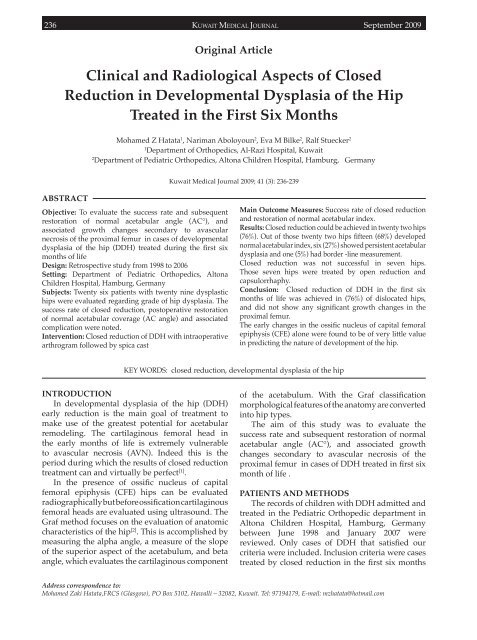Vol 41 # 3 September 2009 - Kma.org.kw
Vol 41 # 3 September 2009 - Kma.org.kw
Vol 41 # 3 September 2009 - Kma.org.kw
Create successful ePaper yourself
Turn your PDF publications into a flip-book with our unique Google optimized e-Paper software.
236<br />
KUWAIT MEDICAL JOURNAL <strong>September</strong> <strong>2009</strong><br />
Original Article<br />
Clinical and Radiological Aspects of Closed<br />
Reduction in Developmental Dysplasia of the Hip<br />
Treated in the First Six Months<br />
Mohamed Z Hatata 1 , Nariman Aboloyoun 2 , Eva M Bilke 2 , Ralf Stuecker 2<br />
1<br />
Department of Orthopedics, Al-Razi Hospital, Kuwait<br />
2<br />
Department of Pediatric Orthopedics, Altona Children Hospital, Hamburg, Germany<br />
Kuwait Medical Journal <strong>2009</strong>; <strong>41</strong> (3): 236-239<br />
ABSTRACT<br />
Objective: To evaluate the success rate and subsequent<br />
restoration of normal acetabular angle (AC°), and<br />
associated growth changes secondary to avascular<br />
necrosis of the proximal femur in cases of developmental<br />
dysplasia of the hip (DDH) treated during the first six<br />
months of life<br />
Design: Retrospective study from 1998 to 2006<br />
Setting: Department of Pediatric Orthopedics, Altona<br />
Children Hospital, Hamburg, Germany<br />
Subjects: Twenty six patients with twenty nine dysplastic<br />
hips were evaluated regarding grade of hip dysplasia. The<br />
success rate of closed reduction, postoperative restoration<br />
of normal acetabular coverage (AC angle) and associated<br />
complication were noted.<br />
Intervention: Closed reduction of DDH with intraoperative<br />
arthrogram followed by spica cast<br />
Main Outcome Measures: Success rate of closed reduction<br />
and restoration of normal acetabular index.<br />
Results: Closed reduction could be achieved in twenty two hips<br />
(76%). Out of those twenty two hips fifteen (68%) developed<br />
normal acetabular index, six (27%) showed persistent acetabular<br />
dysplasia and one (5%) had border -line measurement.<br />
Closed reduction was not successful in seven hips.<br />
Those seven hips were treated by open reduction and<br />
capsulorrhaphy.<br />
Conclusion: Closed reduction of DDH in the first six<br />
months of life was achieved in (76%) of dislocated hips,<br />
and did not show any significant growth changes in the<br />
proximal femur.<br />
The early changes in the ossific nucleus of capital femoral<br />
epiphysis (CFE) alone were found to be of very little value<br />
in predicting the nature of development of the hip.<br />
KEY WORDS: closed reduction, developmental dysplasia of the hip<br />
INTRODUCTION<br />
In developmental dysplasia of the hip (DDH)<br />
early reduction is the main goal of treatment to<br />
make use of the greatest potential for acetabular<br />
remodeling. The cartilaginous femoral head in<br />
the early months of life is extremely vulnerable<br />
to avascular necrosis (AVN). Indeed this is the<br />
period during which the results of closed reduction<br />
treatment can and virtually be perfect [1] .<br />
In the presence of ossific nucleus of capital<br />
femoral epiphysis (CFE) hips can be evaluated<br />
radiographically but before ossificationcartilaginous<br />
femoral heads are evaluated using ultrasound. The<br />
Graf method focuses on the evaluation of anatomic<br />
characteristics of the hip [2] . This is accomplished by<br />
measuring the alpha angle, a measure of the slope<br />
of the superior aspect of the acetabulum, and beta<br />
angle, which evaluates the cartilaginous component<br />
of the acetabulum. With the Graf classification<br />
morphological features of the anatomy are converted<br />
into hip types.<br />
The aim of this study was to evaluate the<br />
success rate and subsequent restoration of normal<br />
acetabular angle (AC°), and associated growth<br />
changes secondary to avascular necrosis of the<br />
proximal femur in cases of DDH treated in first six<br />
month of life .<br />
PATIENTS AND METHODS<br />
The records of children with DDH admitted and<br />
treated in the Pediatric Orthopedic department in<br />
Altona Children Hospital, Hamburg, Germany<br />
between June 1998 and January 2007 were<br />
reviewed. Only cases of DDH that satisfied our<br />
criteria were included. Inclusion criteria were cases<br />
treated by closed reduction in the first six months<br />
Address correspondence to:<br />
Mohamed Zaki Hatata,FRCS (Glasgow), PO Box 5102, Hawalli – 32082, Kuwait. Tel: 9719<strong>41</strong>79, E-mail: mzhatata@hotmail.com
















